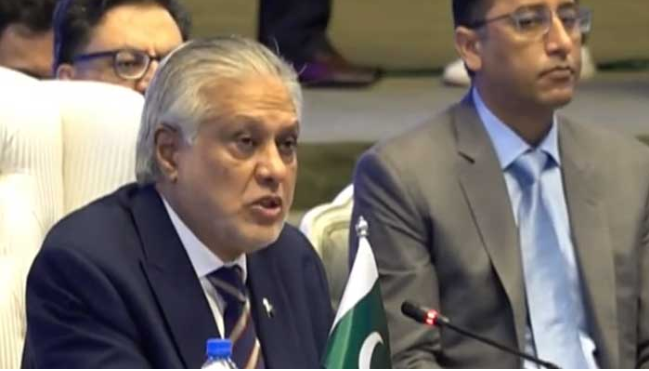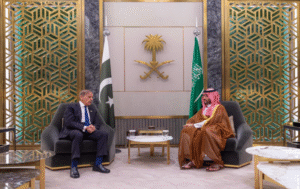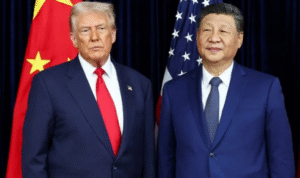Pakistan’s Deputy PM Ishaq Dar Calls CPEC the “Catalyst for Development,” Stresses Regional Connectivity for Economic Growth

Meta Description:
Deputy Prime Minister and Foreign Minister Ishaq Dar highlights Pakistan’s strategic role as a regional hub for connectivity, calling the China-Pakistan Economic Corridor (CPEC) a key driver of economic growth and integration across South and Central Asia.
Introduction
At the Regional Transport Ministers’ International Conference held in Islamabad, Deputy Prime Minister and Foreign Minister Ishaq Dar emphasized that regional connectivity is essential for ensuring long-term stability, inclusive growth, and collective prosperity across Asia.
Dar underscored Pakistan’s strategic geographic position — linking South Asia, Central Asia, the Middle East, and China — as a natural bridge for trade, energy, and infrastructure cooperation. He described CPEC as a “catalyst for development”, accelerating economic transformation and regional integration.
Pakistan’s Strategic Location: A Natural Crossroads
Gateway Between Regions
Dar highlighted that Pakistan’s position at the crossroads of South Asia, Central Asia, and the Middle East places it in a unique position to become a transit and trade hub.
“Our geography offers a unique opportunity to connect diverse regions through road, rail, air, maritime, and digital corridors,” he said. “Pakistan stands ready to play its role as a facilitator of regional integration and economic connectivity.”
He stressed that turning geography into opportunity requires collaboration, investment, and shared commitment among regional stakeholders.
The Vision for Seamless Regional Linkages
Road, Rail, and Air Connectivity
Dar outlined a comprehensive vision of seamless linkages through multi-modal transport systems, including roads, railways, aviation networks, maritime routes, and energy corridors.
According to him, Pakistan’s expanding motorway and highway infrastructure already serves as the backbone of regional and domestic trade, linking key border crossings such as Torkham and Chaman to Gwadar and Karachi ports.
“Efficient and modern transport networks are critical to facilitating cross-border trade and unlocking regional potential,” Dar noted.
Digital Corridors and Energy Integration
He also emphasized the importance of developing digital connectivity and energy-sharing frameworks to ensure that regional integration is technologically advanced and sustainable.
Digital corridors, he explained, will not only improve communications but also enable e-commerce, fintech, and innovation ecosystems, helping the region adapt to the digital economy.
CPEC: The Cornerstone of Regional Development
A Catalyst for Infrastructure and Trade
Calling the China-Pakistan Economic Corridor (CPEC) a “game changer,” Dar noted that the initiative has become a model of connectivity and cooperation.
CPEC, which forms part of China’s Belt and Road Initiative (BRI), links Kashgar in China’s Xinjiang region to Pakistan’s Gwadar Port, covering over 3,000 kilometers of infrastructure, energy, and industrial projects.
“CPEC is widely recognized as a catalyst for energy infrastructure, transport connectivity, and enhanced trade across South and Central Asia,” Dar said. “It embodies Pakistan’s commitment to building partnerships that deliver tangible benefits for the entire region.”
Expanding Regional Reach
He highlighted that CPEC’s benefits extend beyond Pakistan and China, as the project facilitates access for landlocked Central Asian states, providing them with a gateway to global markets.
Through initiatives such as the Karachi-Lahore Motorway, ML-1 railway upgrade, and Gwadar Free Zone, CPEC continues to enhance logistics efficiency, energy availability, and industrial competitiveness.
Regional Collaboration and Shared Prosperity
Building Partnerships Across Borders
Dar emphasized that Pakistan’s approach to regional connectivity is rooted in mutual benefit, inclusivity, and sustainability.
“Our objective is to create win-win partnerships — projects that uplift entire communities rather than serving narrow interests,” he said.
He called for coordinated transport policies, joint investments, and enhanced cross-border facilitation to ensure that every participating country benefits from regional integration.
Strengthening Regional Value Chains
The Deputy Prime Minister pointed out that interconnected economies can better withstand external shocks and global supply chain disruptions.
Pakistan, he said, is prepared to strengthen regional value chains through joint manufacturing zones, technology transfers, and agricultural cooperation — creating employment opportunities and improving regional competitiveness.
Key Connectivity Projects Highlighted
The Uzbekistan-Afghanistan-Pakistan Rail Framework
Dar drew attention to the Uzbekistan-Afghanistan-Pakistan (UAP) Rail Framework Agreement, calling it a landmark initiative that will open new trade corridors across the heart of Asia.
Once operational, this rail network will provide Central Asian nations direct access to seaports, drastically reducing freight time and costs.
“The UAP rail link is a step toward realizing the dream of a connected Eurasia,” Dar remarked. “It symbolizes our collective commitment to shared prosperity.”
Linking Landlocked States to Maritime Trade
He also mentioned that Pakistan’s ports, particularly Gwadar and Karachi, play a critical role in connecting inland trade routes to global shipping lines, effectively making Pakistan a maritime gateway for the region.
The development of Gwadar Port, complemented by energy pipelines and industrial parks, is set to transform Pakistan into a logistics and energy hub.
Transport Minister’s Remarks: Need for Practical Action
During the same conference, Minister for Communications Abdul Aleem Khan echoed Dar’s sentiments and called for “practical and actionable measures” to enhance transport linkages and trade facilitation across borders.
Khan stressed that transport and connectivity are the pillars of economic growth, noting that efficient logistics systems are vital for ensuring competitiveness, resilience, and sustainability in the modern economy.
“The conference provides a valuable platform for sharing experiences, identifying challenges, and building partnerships that bring our communities closer together,” he said.
Pakistan’s Infrastructure Backbone: Roads and Highways
Expanding Motorway Networks
Pakistan’s motorways and highways now span thousands of kilometers, connecting northern, central, and southern regions. These networks serve as arteries of trade, linking industrial zones to border crossings and ports.
Dar noted that the government is investing in upgrading existing corridors, ensuring they meet international standards for freight movement and passenger safety.
Gwadar: The Emerging Trade Hub
He highlighted Gwadar Port’s transformation into a multimodal logistics hub, supported by industrial zones, free trade areas, and energy projects. This development, he said, will stimulate investment and generate employment not only in Pakistan but also for the broader region.
Economic Growth Through Connectivity
From Geography to Geo-Economics
Dar’s speech reflected a key shift in Pakistan’s foreign policy — from geopolitics to geo-economics. This approach prioritizes economic diplomacy, regional integration, and mutual trade benefits over traditional political rivalries.
“Connectivity is no longer a choice; it’s a necessity for sustainable growth,” Dar emphasized. “Our vision is to transform Pakistan from a transit country into an engine of regional development.”
Energy Cooperation and Sustainability
The Deputy Prime Minister reaffirmed Pakistan’s commitment to regional energy projects, including pipelines, power grids, and renewable energy corridors. These efforts, he said, will help overcome chronic energy shortages and ensure a greener, more sustainable regional future.
The Broader Regional Perspective
Lessons from Other Corridors
Regional analysts at the conference cited examples such as the Trans-Asian Railway, Middle Corridor Project, and BRI economic belts, noting that integrated transport networks can reduce poverty, increase trade volumes, and foster people-to-people exchanges.
Pakistan, with its strategic location and growing infrastructure, has the potential to play a central role in this global connectivity network.
Encouraging Private Sector Participation
Delegates also emphasized the importance of public-private partnerships (PPPs) to finance large-scale infrastructure. Pakistan, Dar said, welcomes foreign investors and development banks to participate in transport modernization and digital infrastructure projects.
Digital and Technological Corridors: The New Frontier
In addition to physical connectivity, Dar stressed the need to build digital highways across borders.
These initiatives aim to improve data sharing, cybersecurity cooperation, and innovation ecosystems. With the rise of e-commerce and digital banking, digital integration has become a fundamental component of economic competitiveness.
“The future of connectivity lies in digital collaboration — in enabling our businesses, students, and innovators to connect across borders without barriers,” Dar said.
Challenges to Regional Integration
While the potential for connectivity is immense, Dar acknowledged that political instability, security issues, and bureaucratic barriers continue to hinder regional cooperation.
He urged all countries to prioritize peace, transparency, and consistency in policy frameworks, emphasizing that sustainable progress requires long-term political will and mutual trust.
“We must overcome divisions and work collectively for regional prosperity,” he said.
Conference Outcome: A Roadmap for the Future
The Regional Transport Ministers’ International Conference concluded with a joint declaration reaffirming commitment to cross-border transport facilitation, environmentally friendly infrastructure, and inclusive economic development.
Delegates agreed to enhance policy harmonization, data sharing, and investment coordination, recognizing that regional prosperity depends on shared progress.
Conclusion
Deputy Prime Minister Ishaq Dar’s address underscored a compelling vision: economic growth rooted in regional connectivity. By linking South Asia, Central Asia, and the Middle East through transport, energy, and digital corridors, Pakistan seeks to become a bridge of opportunity in an increasingly interconnected world.
CPEC remains the catalyst for this transformation — a symbol of Pakistan’s commitment to cooperation, progress, and sustainable development. As Dar put it, “Our future prosperity depends on how effectively we connect today.”






